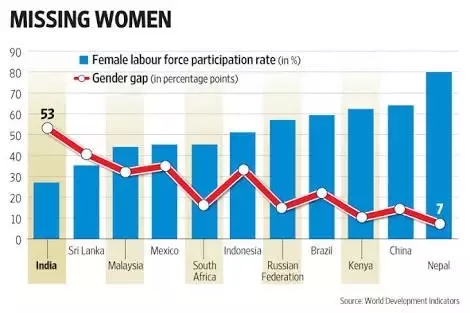Ahmedabad
(Head Office)Address : 506, 3rd EYE THREE (III), Opp. Induben Khakhrawala, Girish Cold Drink Cross Road, CG Road, Navrangpura, Ahmedabad, 380009.
Mobile : 8469231587 / 9586028957
Telephone : 079-40098991
E-mail: dics.upsc@gmail.com

Low Female Labor Force Participation Rate
News: According to recent Periodic Labor force survey (PLFS), India faces significant challenges related to female labour force participation rates (LFPR), particularly in rural areas.
What are Female Labour Force Participation Rates (LFPR)?
• The Female Labour Force Participation Rate (LFPR) is a measure of the proportion of a country’s workingage women (15-59 years) who are employed or are actively looking for work. It is expressed as a percentage of the female working-age population.
Key Issues:
• The PLFS data indicates that for women in the working age group (15-59 years), LFPR is only 35.6 per cent in India with the participation rate being 39.3 per cent and 26.5 per cent, respectively, in rural and urban areas in 2021-22.
• Notably, from 2017 to 2021, women’s LFPR increased relative to men, particularly in rural areas because of the larger engagement of rural women in agriculture and allied activities.
• Rural women working as regular and casual wage workers faced a higher gender wage gap compared to urban women and self-employed women received less than half of men’s earnings, indicating a higher gender earning gap as compared to other categories of workers in rural areas.
• In rural areas, one third of women remained engaged in unpaid domestic chores in 2021-22.
• Despite their crucial role in agriculture, the agriculture census (2015-16) reported that only 14.7 per cent of the operational landholdings were owned by women, reflecting the gender disparity in ownership of landholdings in agriculture.
• Gender-wise beneficiary data highlights that only 15 per cent women farmers received financial support from PMFBY in 2023 and only 25 per cent women farmers received financial benefit under PM-KISAN. Landowning is major criteria for benefit of these schemes, thus many women farmers end up excluded.
Significance of Higher Female Labour force participation rate:
• Directly linked to Economic growth
• When women earn regular incomes it can lift households out of poverty
• Educated and economically active women can positively influence the education and health outcomes of their children, leading to intergenerational benefits.
• Increasing women’s participation in the labour force can help address skill shortages and labor market imbalances, leading to a more efficient allocation of talent and resources.
Reforms necessary in ‘care economy’ to empower women:
• Flexible work hours to accommodate women’s caregiving responsibilities
• Provide training and skill development programs tailored to women’s needs
• Initiate schemes that acknowledge and value unpaid care work. For example, the Mahatma Gandhi National Rural Employment Guarantee Act (MGNREGA) provides wages for certain community and care-related activities.
• Encourage the formation of self-help groups among women, allowing them to engage in economic activities collectively, such as micro-enterprises or agricultural cooperatives.

Address : 506, 3rd EYE THREE (III), Opp. Induben Khakhrawala, Girish Cold Drink Cross Road, CG Road, Navrangpura, Ahmedabad, 380009.
Mobile : 8469231587 / 9586028957
Telephone : 079-40098991
E-mail: dics.upsc@gmail.com
Address: A-306, The Landmark, Urjanagar-1, Opp. Spicy Street, Kudasan – Por Road, Kudasan, Gandhinagar – 382421
Mobile : 9723832444 / 9723932444
E-mail: dics.gnagar@gmail.com
Address: 2nd Floor, 9 Shivali Society, L&T Circle, opp. Ratri Bazar, Karelibaugh, Vadodara, 390018
Mobile : 9725692037 / 9725692054
E-mail: dics.vadodara@gmail.com
Address: 403, Raj Victoria, Opp. Pal Walkway, Near Galaxy Circle, Pal, Surat-394510
Mobile : 8401031583 / 8401031587
E-mail: dics.surat@gmail.com
Address: 303,305 K 158 Complex Above Magson, Sindhubhavan Road Ahmedabad-380059
Mobile : 9974751177 / 8469231587
E-mail: dicssbr@gmail.com
Address: 57/17, 2nd Floor, Old Rajinder Nagar Market, Bada Bazaar Marg, Delhi-60
Mobile : 9104830862 / 9104830865
E-mail: dics.newdelhi@gmail.com